New large-fruited resistant honeysuckle variety Yugana
Starting from the second half of the twentieth century, edible honeysuckle began to be gradually grown in Russian gardens. But even now, for many land owners, the culture is unknown, although it has a lot of unique and useful characteristics. The Yugan variety is one of the most delicious and unpretentious, ideal for inexperienced gardeners, it will provide early berries and enrich the overall appearance of the site with greenery.
Description of the Yugan honeysuckle variety
Yugan's honeysuckle is one of the newest large-fruited varieties. When breeding it, breeders tried to improve the taste of the berry crop without compromising other advantages.
Origin and development, history of breeding
The Yugan variety was bred in 2010 at the Bakcharsky stronghold of the Institute of Horticulture. The scientific institution produces crops with high adaptation characteristics to cold climates and resistance to pests and pathogens.
The Yugan hybrid is the result of crossing the Kamchatsky and Turchaninova varieties.
Characteristics, description of appearance, taste
The base of the honeysuckle bush consists of gnarled skeletal branches that bend slightly at the tops. In spring, many shoots are formed, gradually they become lignified and change color from dark green to brown-brown. Most young branches have bristly hair.
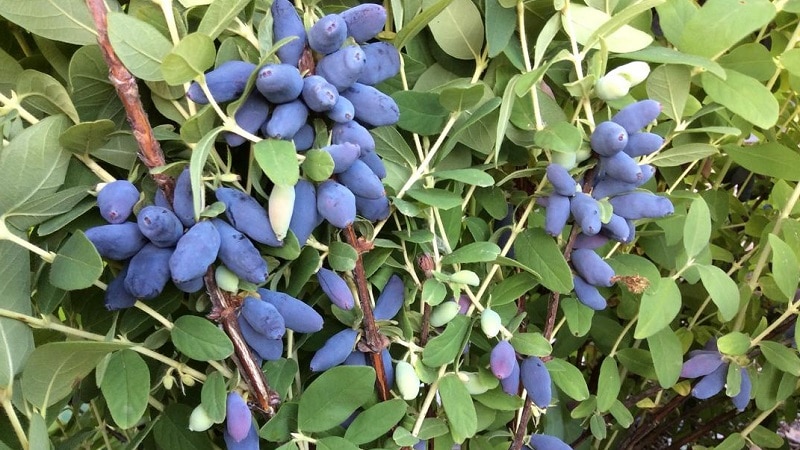
Yugana grows well in length and width.The average height of the shrub is 1.5-1.7 m, the crown is semicircular, compact and neat, its diameter is on average 1.8 m. Adult specimens almost never need pruning to maintain a neat decorative appearance.
The foliage is dark green, ovoid or oval-elongated, located opposite, attached to the branches with thin petioles. The surface of the plates is smooth and glossy; there is sparse pubescence on the reverse side.
The inflorescences consist of fairly large yellow buds with a delicate aroma. They are found on the tops of young shoots or grow from the axils of the leaves.
The berries are sweet and sour, without astringency, dessert, professional tasters rate their taste at 4.9 points. They contain a lot of useful compounds and are ideal for freezing.
Features of the use of this variety
The Yugan hybrid is planted to obtain an early harvest. In terms of the content of nutrients, they are not inferior to blueberries and currants, and according to some evaluation criteria they even surpass them.
Productivity and fruiting
Yugana berries are quite large compared to other varieties of honeysuckle - 2-4 cm long, weight 1.5-2 g.
The shape is fusiform and pitcher-shaped, there is a slight tuberosity, the apex is obtuse. The fruits are blue-violet in color, covered with a light gray waxy coating.
Important! The variety is characterized as high-yielding; an average of 3-6 kg is harvested from a bush per season.
Ripening period
The ovaries are formed in May, and from the end of June the berries are starting to ripen.
Resistance to diseases and pests
Yugana has higher immunity to diseases compared to other varieties. If active reproduction of pathogens and pests of fruit crops occurs on the site, then over time they settle on honeysuckle.
Resistance to cold and drought
Increased frost resistance is an important characteristic of Yugana. The bush can withstand temperatures down to -50°C.
For which regions is it best suited and what are the climate requirements?
Yugan honeysuckle grows well in middle and northern latitudes. In temperate and cold climates there are rarely prolonged thaws, which can awaken the plant too early. In the southern part of the country, the culture takes root normally, but often suffers from prolonged heat.
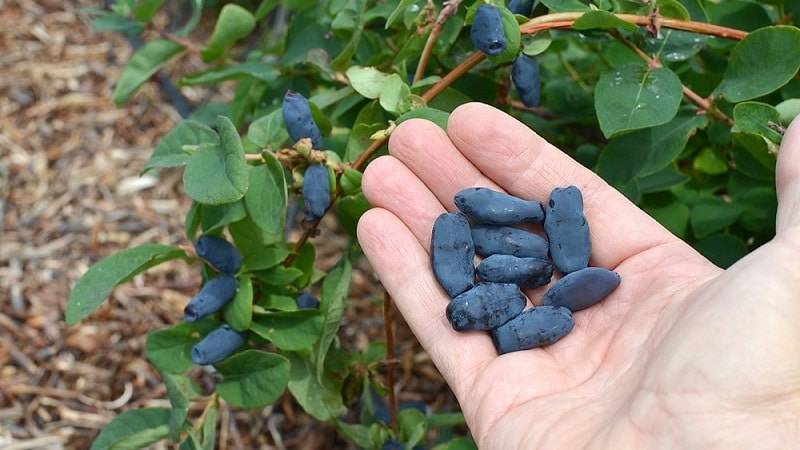
The main advantages and disadvantages of the variety
Advantages of Yugana:
- early ripeness;
- record winter hardiness;
- simple agricultural technology;
- large fruit;
- ripe berries do not fall off;
- stable fruiting.
The main disadvantages of the variety are self-sterility and extended ripening.
What is the difference from other varieties and hybrids
Yugana requires a cool climate and a gradual decrease in temperature from the 2nd half of summer. At this time, in preparation for the new season, the bush changes the color of the foliage to varying degrees or partially sheds it.
Agricultural technology
Caring for Yugana is no different from most fruiting honeysuckles. The success of growth is largely determined by the quality of the seedlings and the planting location.
Choosing a place in the garden and preparing holes
For honeysuckle, a flat, slightly elevated, light, open area with high humidity is allocated, protected from the winds, where melt water does not accumulate. In partial shade, Yugan develops normally, but the yield decreases.
A week before planting, the site is dug up, a bucket of compost and 50 g of phosphorus-potassium fertilizer are added to the planting holes.
Inappropriate neighbors for honeysuckle will be:
- raspberries, blackberries;
- apple and pear;
- sea buckthorn;
- blueberry;
- all stone fruits.
Preparing for landing
Seedlings 2-3 years old are suitable for planting.Signs of quality will be developed roots, flexible shoots without damage and the presence of unopened buds.
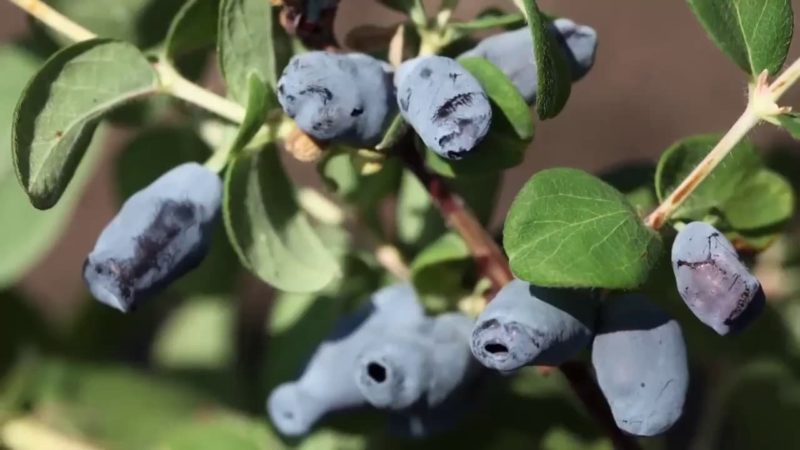
Soil requirements
Preferred for honeysuckle drained sandstones and loams. If the soil is acidic, it is neutralized with lime, ash or dolomite flour. Alkaline soil is normalized with urea and ammonium nitrate.
Dates, scheme and rules of planting
Honeysuckle is planted in autumn, for the middle zone, Siberia and the Urals, the period falls on September - mid-October. in spring The favorable period is the end of April, when the snow has melted, but the buds have not yet opened.
Important! Holes for bushes are made at a distance of at least 2 m. If honeysuckle is planted in rows, then a passage of 2.5 m is made between them.
Landing rules:
- They dig holes 40 cm deep and 45-50 cm wide. The top fertilized layer is thrown aside.
- A mound is formed from several handfuls at the bottom. A seedling is placed on it, the roots are straightened.
- Cover with fertile soil and deepen the root collar to 5-6 cm.
- Compact and water.
Features of cultivation
On hot days, Yugana must be watered and try to keep the root zone moist all the time. Due to lack of moisture, the berries become bitter and small.
Once a week, loosen the soil around the bush. Mulching with any organic matter in a layer of 8-10 cm will greatly facilitate crop care.
Nuances of care
If the soil was fertilized during planting, then the following fertilizing is applied in the second year. In spring, the top layer of soil is mixed with a bucket of compost and a handful of ash. For rapid growth, pour in a solution of 10 liters of water and 2 tbsp. l. urea. In the fall, add 1 cup of ash and 2 tbsp. l. superphosphate.
Sanitary pruning is carried out of necessity. Bushes up to 15 years old do not need formative pruning.After 18-20 years, the old main branches are cut out every year for rejuvenation.
Pollinators
Since Yuga is self-sterile, to form ovaries it needs pollen from other pollinator varieties. Suitable:
- The Giant's Daughter;
- Bakcharsky Giant;
- Strezhevchanka;
- Delight.
3-5 different varieties are planted nearby.
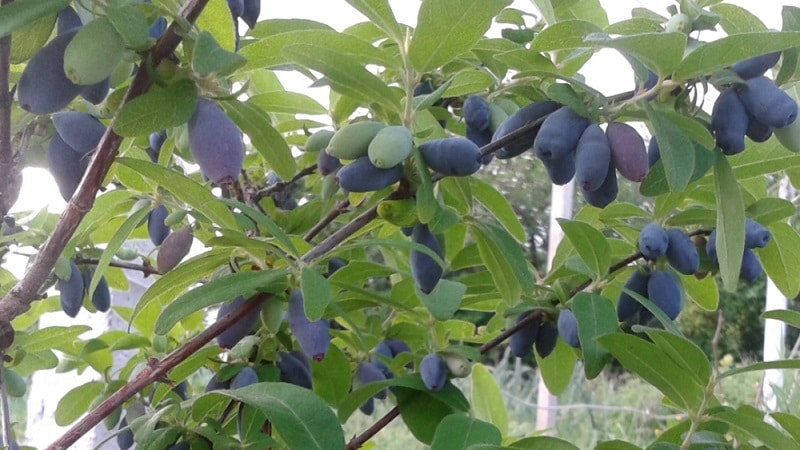
Disease and pest control
The most common diseases:
- rust;
- leaf mottling;
- powdery mildew;
- ramulariasis;
- cercospora;
- blackening of shoots;
- mosaic;
- tubercularosis.
Important! To eradicate diseases, they use fungicides that are suitable for treating fruit and berry crops.
Pests:
- spider mite;
- leaf roller;
- sawfly;
- bug;
- cherry fly;
- aphid.
Preventive spraying with insecticides before buds open and treatment at the first signs of damage will save you from them.
Preparing for winter
Yugana does not need special pre-winter preparation. Like other berry crops, it is watered and mulched in the fall. To be on the safe side, young seedlings are wrapped in agrofibre.
Reproduction
For propagation of honeysuckle they use cutting method:
- in spring, blanks 20 cm long are cut from lignified shoots;
- stuck into fertile soil, watered and covered with a jar;
- Keep in a warm place for a month, moisturize.
During this time, the cutting will take root; it will be replanted in the fall.
Harvesting
Yugana bears fruit annually within 25-30 years.
How and when to collect
The berries ripen gradually at the beginning of summer, so they are harvested in 2-3 times. They lay a film under the bush or place a wide box, tilt the branches slightly and shake them so that the fruits fall off on their own.
What difficulties may there be when growing
The following factors influence the slowdown in growth and the absence of ovaries:
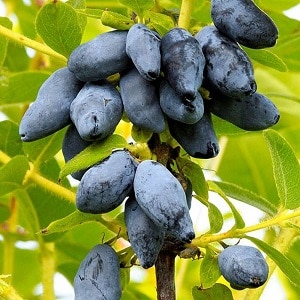 Lack or excess of fertilizers. Excess phosphorus provokes a delay in the development of the ground part of the bush, nitrogen provokes the active growth of shoots to the detriment of the berries.
Lack or excess of fertilizers. Excess phosphorus provokes a delay in the development of the ground part of the bush, nitrogen provokes the active growth of shoots to the detriment of the berries.- Deepening the seedling by more than 40 cm when planting.
- Waterlogging of roots as a result of oversaturation of the soil with groundwater or excessive watering.
- Lack of lighting. In this case, the bush is replanted.
Tips and reviews from experienced gardeners about the variety
Thinning the middle of the crown has a beneficial effect on the yield and ventilation of the crown. Also, to reduce density and improve the overall appearance of the plant, the lowest shoots are removed.
Honeysuckle is transplanted even as an adult. They do this in case of emergency, for example, if the place is not suitable and the bush grows too slowly in height and width. After harvesting, it is dug up with a large lump of earth, planted in prepared soil and watered abundantly.
Many honeysuckle lovers have already appreciated the features of the new variety.
Yuri Zaruza, Poltava: “I have many varieties of honeysuckle. I planted Yuganu in partial shade, all the berries are the same, with sourness. The pulp is looser, I would like it to be sweeter, but I forgive it for its large fruit. Pollinates perfectly".
Tamara, Leningrad region: “I liked Yugana both for its taste and size; it grows faster than the others. I already have others planted Bakchar honeysuckle, they taste similar. I pick Yugana later than the others, the berries are beautiful and large.”.
Conclusion
Yugan honeysuckle is unpretentious in care, prefers a cool climate and moist, fertile soil. To fully exploit the capabilities of the variety, the plant is planted in a sunny place away from large trees. Productivity is high, ripening is extended, but the berries do not fall off.